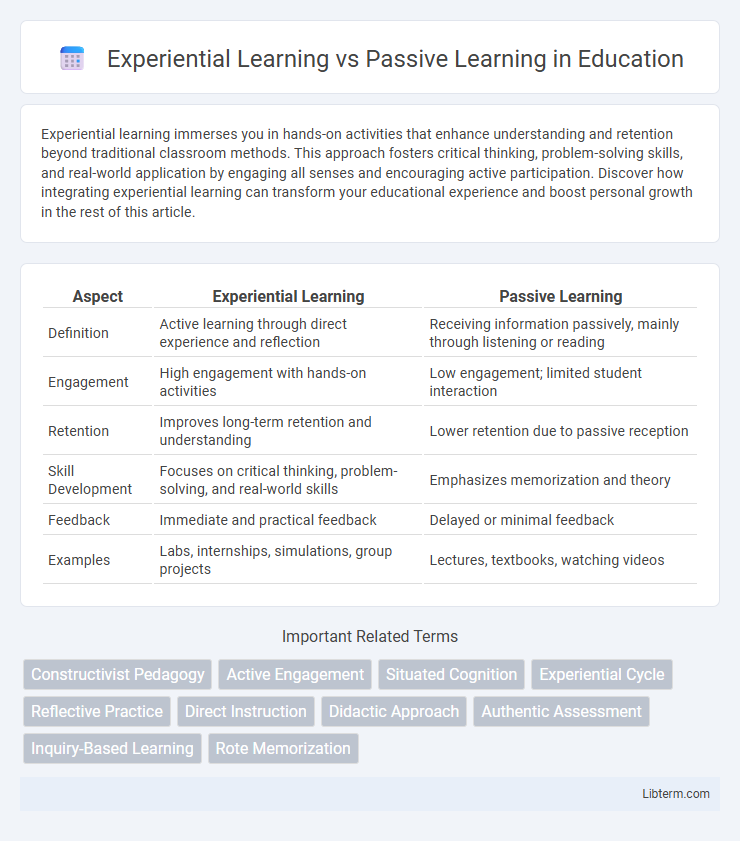Experiential learning immerses you in hands-on activities that enhance understanding and retention beyond traditional classroom methods. This approach fosters critical thinking, problem-solving skills, and real-world application by engaging all senses and encouraging active participation. Discover how integrating experiential learning can transform your educational experience and boost personal growth in the rest of this article.
Table of Comparison
| Aspect | Experiential Learning | Passive Learning |
|---|---|---|
| Definition | Active learning through direct experience and reflection | Receiving information passively, mainly through listening or reading |
| Engagement | High engagement with hands-on activities | Low engagement; limited student interaction |
| Retention | Improves long-term retention and understanding | Lower retention due to passive reception |
| Skill Development | Focuses on critical thinking, problem-solving, and real-world skills | Emphasizes memorization and theory |
| Feedback | Immediate and practical feedback | Delayed or minimal feedback |
| Examples | Labs, internships, simulations, group projects | Lectures, textbooks, watching videos |
Understanding Experiential Learning
Experiential learning involves actively engaging learners through real-world experiences and reflective practices, enhancing knowledge retention and critical thinking skills. This hands-on approach contrasts with passive learning, where learners receive information without interaction, often resulting in lower comprehension and application abilities. Key components of experiential learning include concrete experience, observation, conceptualization, and experimentation, which collectively foster deeper understanding and skill development.
Defining Passive Learning
Passive learning involves the reception of information without active engagement, where learners primarily absorb content through listening or reading without interaction or practical application. This learning style emphasizes memorization and repetition, often leading to decreased retention and limited critical thinking development. In contrast, experiential learning promotes active participation, allowing learners to apply concepts directly and enhance understanding through hands-on experiences.
Core Differences Between Experiential and Passive Learning
Experiential learning emphasizes active participation, where learners engage directly with tasks to construct knowledge through experience, fostering critical thinking and problem-solving skills. Passive learning involves receiving information through lectures or readings without direct interaction, often leading to lower retention and engagement. Core differences include the learner's role--active versus passive--and the depth of cognitive processing, with experiential learning promoting deeper understanding through hands-on involvement.
Cognitive Benefits of Experiential Learning
Experiential learning significantly enhances cognitive benefits by actively engaging learners in real-world problem-solving, which fosters critical thinking and deepens knowledge retention. Unlike passive learning, which often relies on rote memorization, experiential learning promotes higher-order cognitive skills such as analysis, synthesis, and evaluation through hands-on activities. This method improves neural connections related to memory and comprehension, resulting in more effective and long-lasting cognitive development.
Limitations of Passive Learning Approaches
Passive learning methods, such as lectures and rote memorization, often result in limited knowledge retention and reduced critical thinking skills due to minimal student engagement. These approaches fail to promote active problem-solving or real-world application, leading to superficial understanding of complex concepts. Consequently, passive learning restricts the development of practical skills essential for adapting to dynamic professional environments.
Real-World Applications of Experiential Learning
Experiential learning enhances skill acquisition by immersing students in real-world applications such as internships, simulations, and project-based tasks that require critical thinking and problem-solving. This hands-on approach fosters deeper understanding and retention compared to passive learning methods like lectures or textbook reading, which often lack practical engagement. Industries report improved job readiness and adaptability among employees who have undergone experiential learning programs, highlighting its value in professional development.
Engagement and Motivation in Learning Processes
Experiential learning significantly enhances engagement and motivation by involving learners in active, hands-on experiences that promote deeper understanding and retention of knowledge. Passive learning often leads to decreased motivation due to its one-way communication style, limiting opportunities for interaction and practical application. Increased engagement through experiential methods fosters intrinsic motivation, encouraging learners to take initiative and apply concepts in real-world contexts.
Assessment Methods for Both Learning Styles
Experiential learning uses performance-based assessments such as simulations, projects, and real-world problem solving to measure practical skills and critical thinking. Passive learning relies primarily on traditional assessment methods including multiple-choice tests, quizzes, and written exams that evaluate knowledge retention and comprehension. Assessments in experiential learning emphasize application and reflection, whereas passive learning assessments prioritize recall and understanding of theoretical content.
Challenges and Barriers in Implementation
Experiential learning faces challenges such as high resource demands, including time, skilled facilitators, and materials, which can limit scalability in traditional educational settings. Passive learning is easier to implement but often results in lower engagement and retention, creating a barrier to deep understanding. Institutional resistance and standardized testing pressures further hinder the widespread adoption of experiential learning methodologies.
Choosing the Right Approach for Optimal Outcomes
Experiential learning engages learners through active participation, promoting critical thinking and skill development, whereas passive learning relies on receiving information with minimal interaction, often leading to lower retention rates. Selecting the right approach depends on the learner's goals, the complexity of the material, and the desired outcome, with experiential methods excelling in practical skill acquisition and passive methods suited for foundational knowledge absorption. Incorporating a blend of both approaches tailored to specific educational contexts maximizes understanding and application of knowledge for optimal outcomes.
Experiential Learning Infographic

 libterm.com
libterm.com